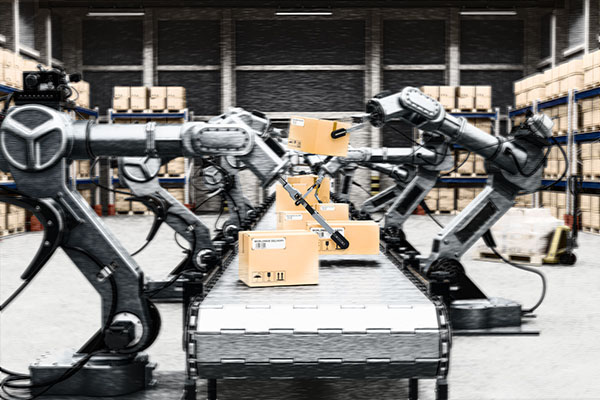There’s no stopping warehouse automation
Already in full force before Covid-19 came about, the push to automate warehouses and distribution centers is expected to pick up as more companies look for ways to manage social distancing rules, remote workforces and other new challenges.
A year that brought with it a whirlwind of uncertainty has also put a bigger spotlight on the use of automation in warehouses and DCs worldwide.
Whether they’re adapting to new social distancing rules, under pressure to distribute a higher volume of essential goods, or trying to add more remote work capabilities, companies are leaning on technology and automation to help them achieve some or all of these goals. Of course, the push to automate the warehouses was in full force before the buzzwords Covid-19 and global pandemic became a part of our everyday language.
At Modex 2020 in Atlanta, for example, both exhibitors and attendees were showing more interest than ever in putting further automation into the world’s fulfillment and distribution facilities. And while some of these operations still run on manual processes, it’s clear that automation is breaking through the barriers as more organizations invest in new technology for their facilities. Modern Material Handling’s “2020 Automation Solutions Study” supports this assumption, proving just how important automation’s role is in the modern warehouse or DC.
For this year’s Peerless Research Group (PRG) survey of Modern subscribers, respondents shared their views of important automation solution features, the extent to which they have implemented automation in their warehouses, and of course, how Covid-19 will impact their future plans. Of the 225 readers who participated in the study, 31% are employed by companies with less than $10 million in revenues and 18% are with firms that fall into the $10 million to $49.9 million category. The bulk of respondents (66%) work for manufacturing firms, while 36% work in a non-manufacturing sector.

The tech evaluation process
When evaluating automation systems and solutions, companies have some clear agendas in mind. Most (89%) want good durability and uptime, followed by support/service response time (81%). Others carefully assess total cost of ownership, return on investment (ROI) and maintenance costs (for 79%), with additional considerations including purchase price, parts availability, risk of obsolescence and integration/compatibility with existing equipment.
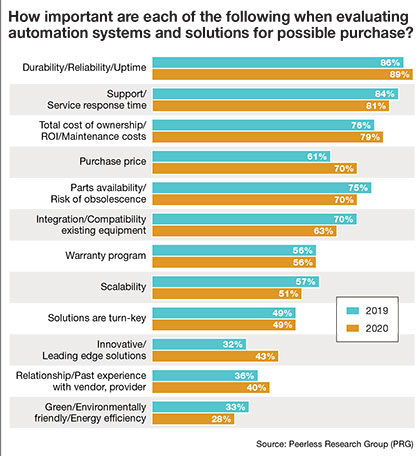
Asked to what extent each of their current warehouse or DC processes is fully automated, the numbers are fairly low, with some dropping since Modern’s 2019 survey. For example, while 15% of companies either have automated reporting or conveyance processes, those numbers fell from 17% and 20% (respectively) over 2019. The use of automated labeling has also decreased, falling to 13% in 2020 (versus 19% in 2019).
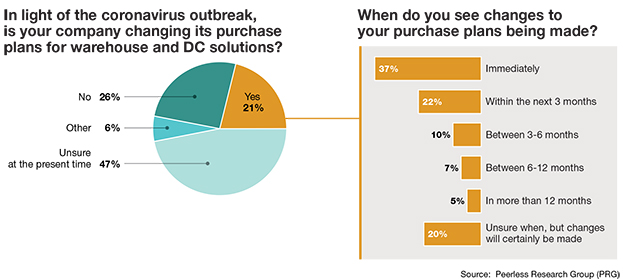
Automation has made a bigger mark in operational areas like labeling, packaging, picking, replenishment, storage and retrieval, all of which reported greater usage numbers compared to last year’s survey. Of the manual processes that are due to be automated soon, reporting is the top pick, with 46% of respondents saying they’ll be automating this function in the near future. Other manual processes that are on the automation agenda right now include conveyance (32%), labeling (39%), packaging (30%) and picking (28%). 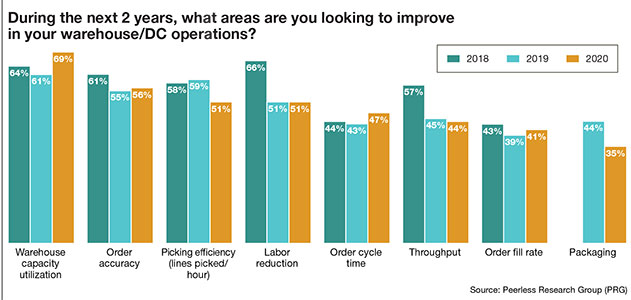
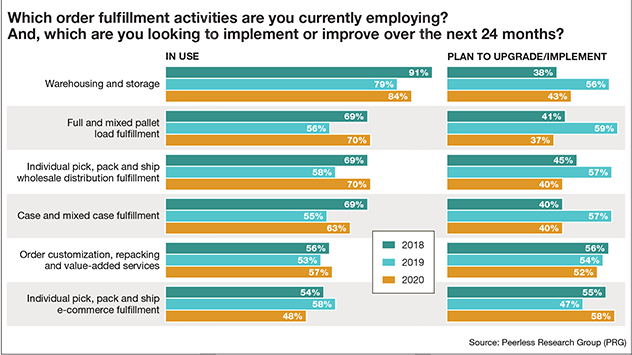
Dealing with disruption
In light of the coronavirus outbreak, 21% of companies surveyed intended to change their plans for purchasing warehouse/DC solutions, while 47% were unsure of their path forward at the time that the survey was administered. Of those companies that were shifting their strategies, 37% were taking immediate steps while 22% expected those changes to come within the next three months.
While some organizations still plan to follow through on their upcoming purchases, it’s clear that Covid-19 has created an environment of uncertainty. “All capex that’s not fundamental is on hold right now,” one respondent said, while several others noted that their companies were “holding tight for now, until further clarity on recovery timing.” In considering which areas of the warehouse or DC they’d like to improve within the next two years, most respondents (69%) say warehouse capacity utilization, up from 61% who gave that answer last year. In addition, 51% of respondents want to improve picking efficiency and 56% are looking to update their order accuracy operations. Interest in labor reduction has decreased from 66% in 2018 to only 51% in 2020 (the same level as 2019).
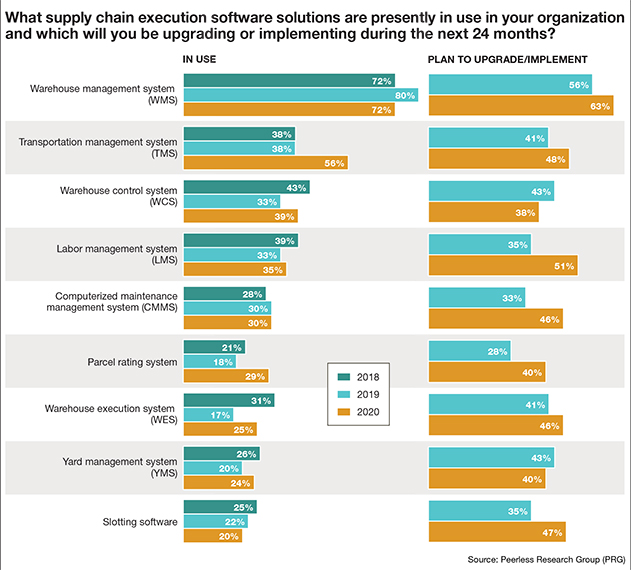
Order fulfillment trends
In describing their current order fulfillment (picking and packing) operations’ automation levels, 5% consider this aspect of their operations to be “highly automated,” while 46% say they’re using a mix of automated and manual processes. Those numbers increased from 4% and 43% respectively, compared to 2019. Presently, 45% of order fulfillment operations are handled mostly or completely manually, a number that fell from 49% the prior year. In terms of order fulfillment activities, most companies (84%) use warehousing and storage; full and mixed pallet load fulfillment (70%); and individual pick, pack and ship wholesale distribution fulfillment (70%). Sixty-three percent are using case and mixed case fulfillment (up from 55% last year), and 57% are using order customization, repacking and value-added services (versus 53% in 2019). The only decline was in individual pick, pack and ship e-commerce fulfillment, which fell from 58% usage in 2019 to a current 48%. 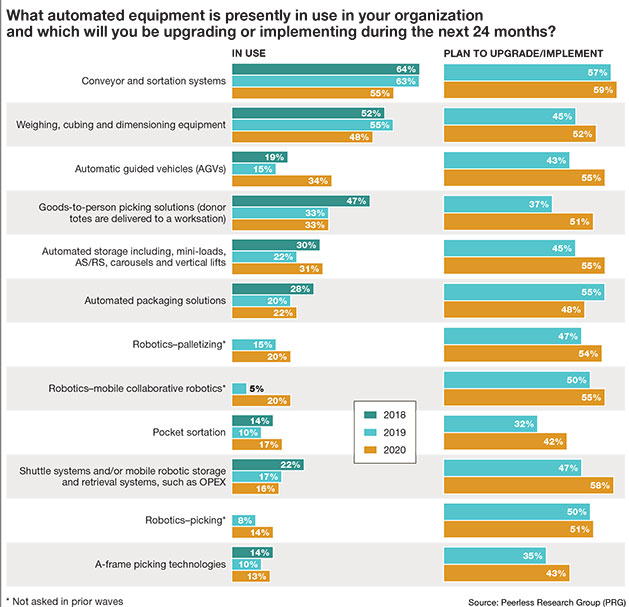
Over the next 24 months, 58% of companies want to implement or improve current individual pick, pack and ship e-commerce fulfillment activities, while 52% are most interested in enhancing their order customization, repacking and value-added services. Forty-three percent see room for improvement in their warehousing and storage operations, while 40% want to do a better job with case and mixed-case fulfillment.

Conventional equipment is popular
As automation continues to work its way into modern warehouses and DCs, conventional equipment is playing an important role in these operations. Eighty-nine percent of respondents say they are currently using racks and shelving (down from 93% last year), while 85% rely on lift trucks (versus 92% in 2019). Other key pieces of conventional equipment used to run the warehouses include dock equipment, palletizers, pallets, totes, binds, containers, hoists, cranes and monorails. Of these various pieces of conventional equipment, companies are most interested in upgrading or implementing hoists, cranes and monorails (according to half of the respondents); palletizers, pallets/totes, bins and containers (49%); and lift trucks (47%).
Automated equipment rocks
Automatic guided vehicles (AGVs) and mobile collaborative robots continue to make their way into the fulfillment environment, where 34% and 20% (respectively) of respondents are presently using this automated equipment. While conveyor and sortation systems remain the most popular form of automated equipment currently in use, their usage fell to 55% this year (from 63% in 2019). Weighing, cubing and dimensioning saw a similar decrease in usage from 55% in 2019 to 48% in 2020. Looking out 24 months, conveyor and sortation systems remain at the top of the respondents’ shopping lists, with 59% saying they plan to include them in their operations in the future. Fifty-eight percent plan to invest in shuttle systems and/or mobile robotic storage and retrieval systems (versus 47% in 2019), while 54% plan to implement palletizing robots (up from 47% last year). Goods-to-person picking solutions saw a large uptick, with more than half of respondents (51%) planning to implement this equipment (up from 37% last year).
The hunt for more data
Within the warehouse, the popular data collection technologies by far are bar code scanners (85%) and mobile/wireless technologies (73%). Heads-up displays and other vision technologies have seen the biggest uptick in usage, from 6% in 2019 to 16% in 2020. RF terminal technologies (28%) and pick- or put-to-light picking (22%) usage remains moderately popular. Within the next two years, 55% of companies plan to implement pick- or put-to-light technology (up from a current 22% usage rate). RFID is also a popular choice, climbing from 49% in 2019 to 55% in 2020. Voice-directed picking technologies (for 55% of respondents), and heads-up display and vision technologies (52%) are also working their way into more warehouses and DCs. Fifty-one percent of companies plan to implement mobile and wireless technologies (down from 56% in 2019), and half of them want new bar code scanners (down from 55%).
Software usage trends
For warehouses, transportation management systems (TMS) saw the biggest increase in current usage, from 38% in 2019 to 56% in 2020. Warehouse management systems (WMS) still remain the most popular software option, with 72% of respondents currently using WMS (versus 80% last year). Warehouse equipment control systems (WCS) usage fell from 39% in 2019 to 33% in 2020. Use of parcel rating systems jumped from 18% in 2019 to 29% to 2020, while warehouse execution systems (WES) usage grew from 17% in 2019 to 35% in 2020.
Over the next 24 months, 63% of companies are planning to implement WMS (up from 56% in 2019); 51% want to add labor management system (LMS); 48% plan to adopt TMS; and 47% want to start using slotting software. Finally, the number of respondents that plan to adopt a parcel rating system increased from 28% in 2019 to 40% in 2020. Currently, 70% of respondents use an enterprise resource planning (ERP) system, up from 52% last year. Use of order management systems (OMS) also saw a significant uptick to 56% from 47% last year. Other popular supply chain management software platforms include customer relationship management (CRM), supply chain planning (SCP) and distributed order management (DOM).
Purchasing habits
Presently, 72% of respondents purchase their order fulfillment solutions from a distributor/dealer, while 67% buy directly from the manufacturer, and 44% are working with integrators. For 2020, 35% of companies plan to spend less than $100,000 on such solutions, while 18% will spent up to $2.4 million. Thirteen percent will spend more than $5 million, while the average allocation will be $1.2 million (just under the $1.4 billion they expected to spend in 2019). Last year, 33% of firms were expecting an increase in spending, but this year only 24% plan for that. This could be caused by the uncertainty related to Covid-19, or simply because more companies have already started to establish their stables of automated equipment and software. In 2020, 31% of survey respondents say that their spending will stay the same, while 16% think it will decrease, and 29% think it’s too soon to tell.


